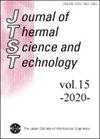柴油喷雾中液滴粒径对二次破碎的降低率
IF 0.9
4区 工程技术
Q3 THERMODYNAMICS
引用次数: 0
摘要
惯量与表面张力之比。摘要为了评价通用型液滴破碎过程,对两种不同规格的螺线管喷油器喷射的柴油喷雾进行了测量。用激光双焦测速仪(L2F)测量了喷雾液滴的速度和大小。将跟随气流的小液滴的速度作为空气的速度。使用液滴相对于空气的速度作为代表性速度来评估韦伯数。由于喷雾呈锥形扩张,喷嘴孔位于顶部,因此测量点被放置在距离顶部的直线上,这是估计液滴的飞行方向。考虑到飞行方向上液滴尺寸的变化是由于二次破碎造成的,并对这一过程中液滴尺寸的减小速率进行了评估。结果表明,两种喷嘴喷射的喷雾内液滴的速度和大小随时间的变化而变化,韦伯数的空间分布和喷射中期液滴大小减小的速率不均匀且不同。结果表明,两种雾剂的韦伯数与雾滴尺寸减小率之间存在正相关关系,尽管两种雾剂的特性不同,但两者之间的关系几乎相同。结果表明,二次破碎过程与喷嘴直径和孔数等喷射条件无关。本文章由计算机程序翻译,如有差异,请以英文原文为准。
Droplet size decrease rate of secondary breakup in diesel fuel sprays
ratio of inertia to surface tension. The droplet breakup constructed analysis Abstract Targeting the evaluation of the universal droplet breakup process, measurements were made on diesel fuel sprays injected from two solenoid type injectors with different specifications. The velocity and size of the spray droplets were measured using a laser 2-focus velocimeter (L2F). The velocity of small droplets that follow the flow was taken as the air velocity. The Weber number was evaluated using the velocity of the droplets relative to air as the representative velocity. Since the spray expands in a conical shape with the nozzle hole at its apex, the measurement points were placed on a straight line from the apex, which is the estimated flight direction of droplets. The change in droplet size in the flight direction was considered to be due to secondary breakup, and the rate of decrease in droplet size during this process was evaluated. It was confirmed that the velocity and size of the droplets inside the spray injected from the two injectors varied over time, and the spatial distribution of the Weber number and the rate of droplet size decrease in the middle of the injection period was non-uniform and different. It was found that there is a positive correlation between the Weber number and the rate of droplet size decrease for both sprays, and that the relationship is nearly identical despite the fact that the characteristics are different between the two sprays. The secondary breakup process was shown to be independent of the injection conditions such as the diameter and number of nozzle holes.
求助全文
通过发布文献求助,成功后即可免费获取论文全文。
去求助
来源期刊
CiteScore
2.30
自引率
8.30%
发文量
0
审稿时长
5 months
期刊介绍:
JTST covers a variety of fields in thermal engineering including heat and mass transfer, thermodynamics, combustion, bio-heat transfer, micro- and macro-scale transport phenomena and practical thermal problems in industrial applications.

 求助内容:
求助内容: 应助结果提醒方式:
应助结果提醒方式:


